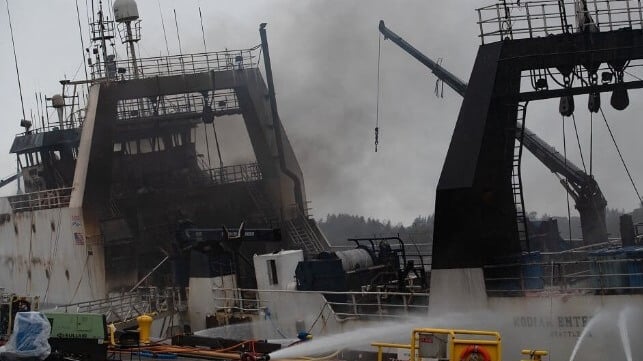NTSB: Fire Alarm Aboard Kodiak Enterprise Never Sent an Alert

The National Transportation Safety Board has released its report on the blaze aboard the factory trawler Kodiak Enterprise, which was declared a total loss after catching fire at the pier in Tacoma last year.
In the early hours of April 8, 2023, a fire broke out in the dry stores compartment of the fishing vessel Kodiak Enterprise. The vessel was in port for a regular yard period, including cutting and welding of wasted hull and bulkhead sections. Four crewmembers from the engineering department were staying on board.
On April 7, repair contractors were aboard to carry out hot work on the pilot house, hold deck, 03 deck and on a variety of vent pipe valves. The dry stores cargo hatch on the 03 level was propped open so that the workers could run a forced air ventilation hose into the interior.
They finished and disembarked at about 1530 hours. The assistant chief engineer inspected the work areas after they left, and all looked to be in order. All four crewmembers were in bed by about 2200 hours, and there were no signs of trouble as late as 0215, when the electrician woke up and left for the airport.
At 0300, a deckhand on another nearby ship was on deck and spotted smoke rising from the deck locker hatch on Kodiak Enterprise's foredeck. He walked down the pier to investigate, and saw that the smoke was getting thicker; it smelled like burning wood, he later told investigators. At 0310, he ran to tell the facility security guard.
The guard made a 911 call at 0319, nearly 20 minutes after the first sign of trouble was spotted. He also called the port engineer, who then called Kodiak Enterprise's chief engineer to wake him up and tell him that there was a fire on board the ship. This was the first notification that the onboard crew received that there was something wrong. The engineer woke up the other two crewmembers who were still on board, and they went to investigate. Smoke was beginning to come down the passageway from the galley. All three of them immediately evacuated.
At 0327, the first shoreside firefighting team arrived on scene. The local firefighters entered on the 01 deck level and began to extinguish flames in the galley; they noticed that the 02 deck level above them was already ablaze.
Trident called salvor Resolve Marine, which has a base in Tacoma. Resolve's crew began setting up their response command post at 0615, and joined the effort.
By that evening, the responders decided to change their approach and switched to boundary cooling, hoping to slow the spread of the blaze. Meanwhile, another response team made plans to remove hazardous liquids and the ship's supply of refrigerant (freon). The fire burned through the vessel over the course of the next six days, and was finally out by April 14. The ship was damaged by smoke and heat throughout, and was declared a total loss.
A federal fire investigator determined that the origin of the fire was likely in the dry stores compartment, which was filled with wooden shelving and cardboard boxes of supplies. The report concluded that the cause of the blaze was an "unknown electrical failure" in this compartment, unrelated to hot work.
NTSB homed in on the fact that the crew and the shoreside management never received any notification from the ship's automated fire detection system. The system was designed to send an alarm via text or email when it was set for in-port operation, but the port engineer only learned of the casualty when the security guard called. Likewise, the crew never heard a fire alarm - it was not set up to sound in accommodations spaces - and could potentially have been affected or killed by smoke inhalation if they had not been woken up by personnel on shore. The lack of an alarm delayed the firefighting response, allowing the fire to grow for at least 19 minutes longer than the point when visible smoke emerged from the hatch.
The wirelessly-connected detector system was badly damaged by the fire, so it was not possible to determine why it did not function as designed.
"When the vessel is undergoing repair work that can cause false alarms, such as hot work, crewmembers should check the fire detection and notification system to ensure it is operating following the completion of work," cautioned NTSB. "Additionally, crewmembers living or staying on board a vessel while it is in port should be included on the system’s designated contacts to be notified immediately."
